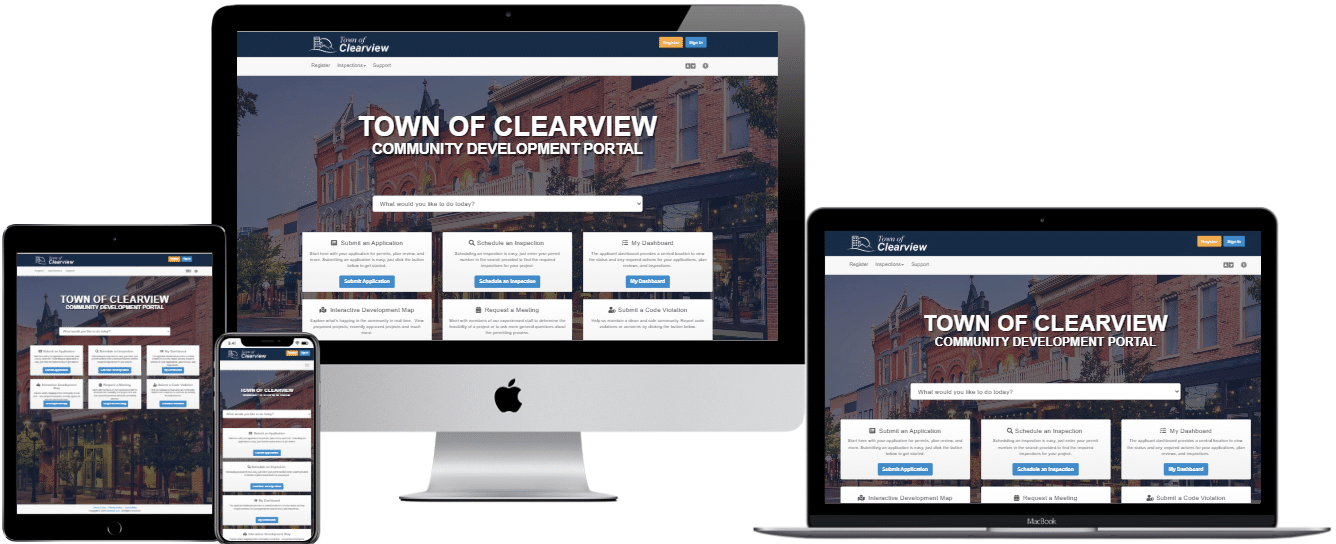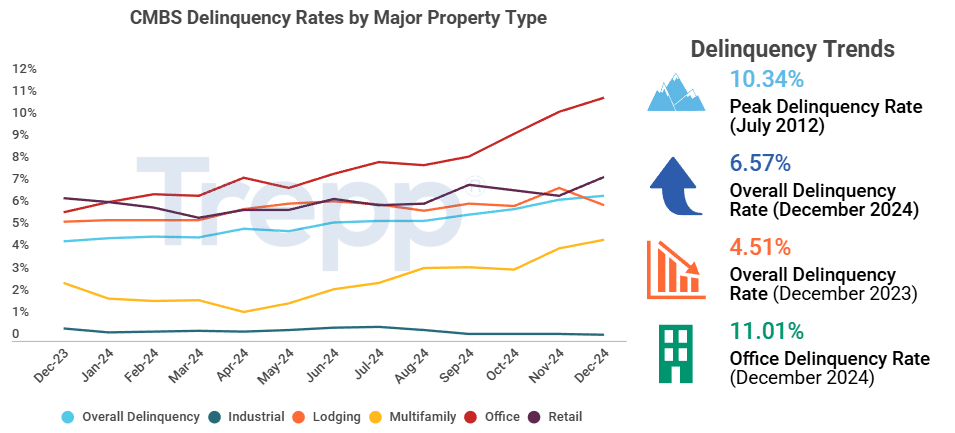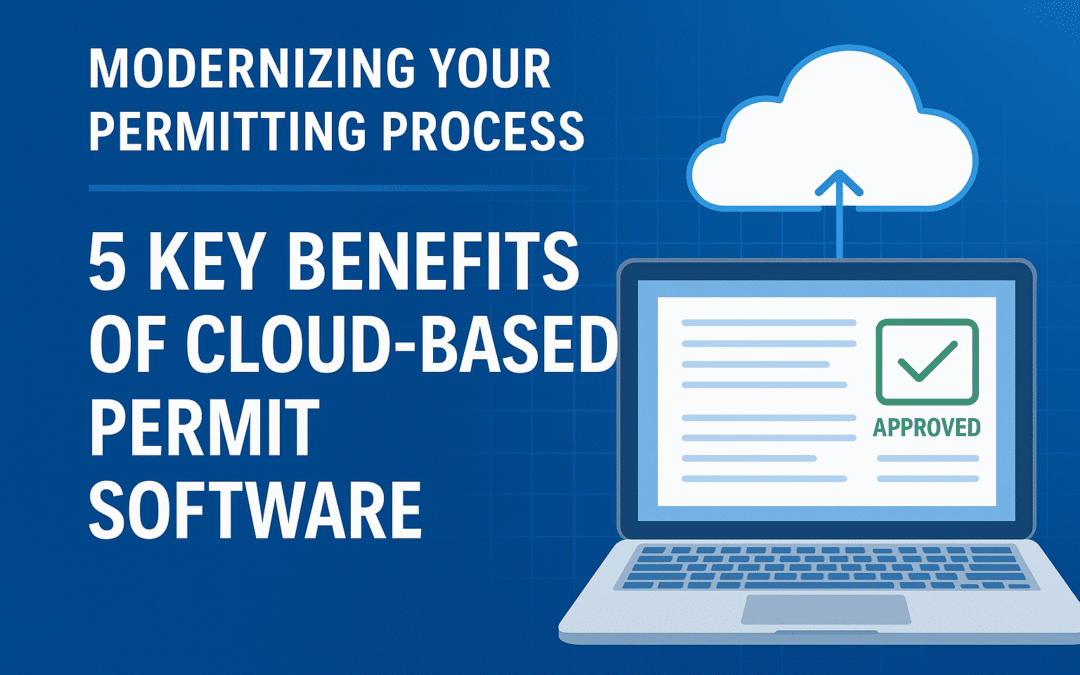What Is Permit Software?
Permit software (also referred to as permit management software or permit tracking software) is a digital system that streamlines the process of submitting, reviewing, and issuing permits. In essence, it replaces manual, paper-based permitting with an online platform that centralizes all permit applications and workflows. State and local governments across the U.S. use permit software to manage a wide range of permits (building, zoning, environmental, business licenses, etc.) in one place. By moving permitting into the cloud, agencies can eliminate paperwork, reduce in-person visits, and ensure that every step from initial application to final approval happens efficiently in a single system.
What Does Permit Software Do?
Permit software digitizes the entire permit lifecycle, making the process easier for both applicants and government staff. Here’s what it does, step by step:
Online Application Submission
Applicants (residents or businesses) can apply for permits through an online portal instead of filling out paper forms or making trips to city hall. The software guides users to input all required information and upload plans or documents. This not only saves time, but also helps ensure applications are complete and legible from the start.
Automated Workflow & Review
Once submitted, the application is routed to the appropriate staff and departments for review. Workflow automation moves the application through various stages such as, zoning review, building plan check, and fire safety review without manual handoffs. Each reviewer can log in to see the application, provide comments or corrections, and mark approvals. The system sends notifications or tasks to the next person in line, so nothing falls through the cracks.
Central Tracking & Communication
Permit software provides a centralized dashboard where staff can track the status of every permit in real time. Instead of juggling spreadsheets or paper files, all information (plans, comments, inspections, fees) is organized under the permit record. This serves as a single source of truth, anyone involved (planners, inspectors, department heads) can see updates or add notes. The software often includes communication tools or email updates to keep applicants informed of status changes, requests for more info, or approval decisions. This transparency improves accountability and customer service.
Inspection Scheduling & Completion
For permits that require field inspections (like construction inspections or site visits), permit management software integrates inspection scheduling. Applicants or staff can schedule inspections through the system, and inspectors can conduct inspections using a mobile app or tablet in the field. Results, checklists, and photos are uploaded directly into the permit record. This real-time approach speeds up the cycle since inspectors don’t need to return to the office to file reports, and any issues can be communicated and resolved faster.
Issuance & Archiving
Once all reviews and inspections are passed, the software allows staff to issue the permit (often as a PDF certificate or similar) to the applicant. Applicants can download or receive their approved permit online. The system then archives the permit record for future reference. All data is stored securely and can be searched or reported on later, which can prove to be very useful for compliance audits or public records. Years down the line, anyone can retrieve the complete history of a project’s permit, including who approved it and when.
In short, permit software replaces a slow, paper-driven process with a modern, electronic workflow. A task that once required shuffling papers between desks and waiting weeks for updates can now be handled in days or hours with online permit management. This not only accelerates approvals but also minimizes errors (since the software can enforce required fields, attach relevant codes, etc.) and improves inter-departmental coordination. Many U.S. cities and counties have made the switch to digital permitting for these reasons, especially as citizen expectations shift toward convenient, on-demand services.

Key Features of Permit Management Software
A quality permit management software solution offers a variety of features to handle every aspect of permitting. Here are some of the key features to look for:
Online Citizen Portal for Applications
An intuitive Citizen Access Portal allows the public to submit permit applications 24/7 from any device. Users can create accounts, fill out forms, upload plans or photos, and track their application status online. This feature reduces in-person foot traffic and makes the process more convenient for applicants. It also means staff receive complete, typed applications that are easier to review.
Customizable Forms & Workflow Automation
Permit software lets agencies configure digital application forms to capture all necessary information for each permit type. Behind the scenes, workflow automation routes applications to the right people (e.g., plan reviewers, department approvers) in the correct order. Automated email notifications and task assignments keep the process moving without manual prodding. You can often set service-level targets or reminders so that if a review is taking too long, the system alerts staff or escalates the issue. This dramatically reduces bottlenecks and ensures a standardized process for every application.
Electronic Plan Review Integration
Handling construction drawings and plans is a major part of issuing building permits. Modern permitting software integrates with electronic plan review tools so that plan examiners can mark up digital blueprints, add comments, and verify corrections entirely online. Features like version control, mark-up tools, and side-by-side comparison of revisions help streamline plan checking. This eliminates the need for physical plan sets and multiple resubmittals allowing reviewers and applicants to collaborate in a shared digital space for faster approval cycles.
Document Management & Record Keeping
A robust document management system underpins permit software. All files related to an application including forms, plans, photos, permits, and correspondence are stored in the system and tied to the permit record. This organization means no more hunting through file cabinets or email chains for a missing document. It also improves transparency and auditability: every action taken on the permit (edit, approval, inspection result) can be logged with a timestamp. Staff and applicants alike benefit from this clear trail, ensuring accountability at each step.
Inspection Management & Mobile Access
Top permit systems include a module for inspection management. Inspectors in the field can use tablets or smartphones to view assigned inspections, enter results, and upload photos/videos on-site, even offline while data syncing later. Checklists and code reference libraries ensure inspections are thorough and consistent. By standardizing inspections and allowing real-time updates from the field, agencies speed up the process and avoid duplicate data entry (no need to re-type notes back at the office). Applicants can also request or view inspection appointments through the online portal, keeping everyone on the same page.
Fee Processing & Payments
Online payment processing is another key feature. The software can calculate permit fees (and any other associated fees like plan review fees or impact fees) automatically based on your agency’s fee schedules. Applicants can then pay securely online via credit card or e-check. Integrations with payment gateways or financial systems ensure funds are tracked. Accepting payments through the permit portal speeds up revenue collection and saves applicants a trip to drop off a check. It also provides immediate confirmation of payment and can even issue receipts or mark the permit as paid, simplifying financial reconciliation for staff.
Compliance Tracking & Code Integration
Ensuring that projects meet all local codes and regulations is central to permitting. Permit software often includes compliance tracking features. For example, checklists or rules engines that verify an application meets zoning rules, building codes, or environmental regulations. Staff can flag non-compliance issues in the system and require applicants to address them before approval. Many systems allow you to update code requirements over time, so the software stays aligned with the latest laws. This reduces the risk of permits being issued in error and helps enforce regulations consistently across all applications.
Reporting and Analytics
With all permitting data in one database, agencies can generate valuable reports and metrics. Built-in reporting tools let users track things like the number of permits issued, average approval times, fees collected, or inspector workloads. Analytics dashboards might highlight trends (e.g. surge in solar permits, or average time in each workflow stage) that help management identify bottlenecks or plan staffing. Some advanced platforms even leverage AI for insights, but even basic statistics support data-driven decisions. For example, if you see that one permit type consistently takes twice as long to approve, you can investigate why and improve the process. Reporting also aids transparency, some jurisdictions publish permit dashboards or scorecards to show the public how they are performing.
Integrations with Other Systems
Permit management rarely happens in isolation. Good permit software will integrate with GIS (Geographic Information Systems), so staff can visualize permits on a map or verify parcel information. It may link to your city’s address database or property records to auto-fill details. Integration with municipal CRM or 311 systems can connect service requests to permits. Connections to electronic plan review (as mentioned), contractor licensing databases, or even external agencies (like health or fire departments) can further streamline workflows. Additionally, open APIs (Application Programming Interfaces) allow agencies to build custom integrations or data exchanges. The ability to connect with other software (from financial systems for fee tracking to document archives for long-term storage) is crucial for a seamless IT ecosystem.
In summary, these features work in concert to provide a comprehensive permit management solution. When evaluating options, agencies should look for software that covers the full spectrum. From a friendly citizen portal on the front end, to powerful workflow and inspection tools on the back end, plus the flexibility to adapt to your specific permit types and integrate with your existing tools.
Benefits of Permit Software
Implementing permit software brings significant advantages for municipalities, staff, and the communities they serve. Below are some of the key benefits of moving to a modern permit management system:
Faster Permit Approvals
One of the most immediate benefits is speed. By automating workflows and eliminating paper hand-offs, permit software drastically reduces processing times. Many governments have reported dramatic improvements, for example, Newark, NJ cut its business license approval timeline from roughly 12 months to just 30 days after moving the process online (a 90% reduction). In general, studies have found that switching from manual permitting to digital platforms can accelerate permit processing by 75% or more. Faster approvals mean projects can break ground sooner, which is a win-win: it keeps developers happy and can boost local economic activity by not letting development stall in red tape.
Increased Efficiency & Cost Savings
Permit software allows staff to do more with less effort. Routine tasks like data entry, file organization, and status tracking are handled by the system, freeing up staff to focus on higher-value work (like helping applicants or tackling complex reviews). The paperless approach yields direct cost savings too, less money spent on printing, mailing, and physical storage. Going digital can save thousands of sheets of paper and associated costs each year, not to mention being more eco-friendly. In fact, one community in Colorado reported saving over 15,000 sheets of paper and eliminating 1,400 office visits annually, while cutting administrative processing time in half by switching to online permitting. These efficiency gains can also help stretched departments handle growing permit volumes without needing proportional increases in staff.
Better Collaboration & Transparency
With a centralized permit system, everyone involved in the process stays on the same page. Multiple departments can review an application concurrently or sequentially within the same platform, seeing each other’s comments and updates in real time. This collaboration reduces miscommunication and ensures that issues are caught early. It also provides transparency for applicants and the public. Rather than calling the office for updates, applicants can log into the portal and see exactly where their permit stands and what (if anything) is needed. The improved transparency not only builds trust but also enhances customer service, as citizens experience a more predictable, open process. Internal transparency is improved too: managers have a bird’s-eye view of all pending permits and can easily monitor workloads and timelines.
Improved Compliance & Consistency
Permit software helps enforce consistent processes and code compliance. By using standardized forms, checklists, and automated rules, the software makes sure every application goes through the proper reviews and meets the necessary regulations. This consistency reduces the chance of human error or oversight (such as a step being skipped or an outdated code being applied). It also creates an audit trail; if questions arise later (for example, “How was this permit approved?”), you have a clear record of who reviewed what and when. In addition, many systems require applicants to submit all required information up front, meaning staff spend less time chasing down missing pieces. Overall, the result is higher quality control, fewer compliance issues, and a smoother experience for both officials and applicants.
Enhanced Reporting & Decision-Making
Another benefit is the wealth of data that becomes available. With all permit activities tracked, leaders can generate reports to evaluate performance like average permit turnaround time, number of permits issued per quarter, fee revenue collected, etc. These insights support data-driven decision making. For instance, if certain permit types consistently take too long, you might allocate more resources or streamline the requirements. If you see a rise in particular permit categories (say, solar panel installations), you can plan outreach or adjust staffing accordingly. Data also helps communicate the department’s impact to elected officials or the public, demonstrating improvements over time. In short, better reporting leads to more informed management and continuous improvement of the permitting process.
Happier Stakeholders & Economic Benefits
By delivering faster, more efficient service, permit software tends to improve overall satisfaction. Citizens and contractors appreciate being able to handle permits online without hassle, and they get approvals more quickly. Happier customers mean fewer complaints to city hall. On the staff side, employees benefit from less tedious paperwork and clearer processes, which can boost morale and productivity. There are broader community benefits too: streamlined permitting can spur economic development by removing unnecessary delays for new businesses and construction projects. Developers are more likely to invest in a city where they know approvals are timely and predictable. In the long run, this can lead to a stronger local economy and increased revenue for the municipality (for example, faster permitted projects can start generating property tax and other fees sooner). In summary, efficient permitting software doesn’t just make the bureaucracy run better, it actually contributes to community growth and satisfaction.
About GeoCivix
GeoCivix is a leading provider of cloud-based permitting and community development software for local governments. Our modern platform helps cities, counties, and towns streamline the entire permit management lifecycle from online submittals and plan reviews to inspections, approvals, and beyond. GeoCivix is known for its intuitive tools and exceptional customer support, empowering staff to go paperless while improving service to citizens. We work closely with agencies as a partner, offering deep expertise in configuring the system to fit your unique workflows.
Ready to modernize your permitting process? Schedule a call with a GeoCivix solutions architect to discuss your permitting goals and see whether GeoCivix is a good fit for your organization. We’ll explore your needs and show you how our solution can help you achieve faster approvals, greater efficiency, and happier constituents. Let’s transform your permitting together!












